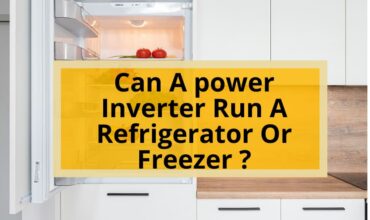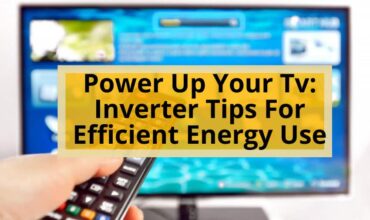Inverter power has become a popular solution for households looking to have a backup power source during power outages or to live off-grid. However, understanding how long appliances can run on different wattage inverters and battery setups can be a challenge.
A variety of factors play a role in determining how long appliances can run on inverter power, including battery bank size, appliance power draw, and frequency of use. In this article, we will explore the different wattage inverters and battery setups, as well as the workload and type of battery used to determine how long your appliances can run on inverter power.
The wattage of an inverter and the voltage of the battery are two of the most important factors affecting how long appliances can run on inverter power. The wattage of an inverter determines the amount of energy it can supply, while the voltage of the battery determines how much energy it can store.
Therefore, the higher the wattage of an inverter and the larger the battery bank, the longer appliances can run on inverter power. However, the power draw of the appliances being used also plays a crucial role in determining runtime, as appliances with high power draw will use more energy and drain the battery faster.
By understanding these factors, we can determine how long appliances can run on inverter power and make informed decisions about which inverter and battery setup to use for our needs.

Factors Affecting Runtime
The duration of an inverter’s runtime is influenced by various factors, including the battery bank size, appliance power draw, frequency of use, inverter wattage, and battery voltage. The battery bank size is a crucial factor that determines the runtime of an inverter. A larger battery bank can provide more power and, therefore, increase the runtime of the inverter.
The frequency of use is also a significant factor that affects the runtime of an inverter. If the inverter is used frequently, the battery will drain faster, reducing the runtime.
In addition, the inverter wattage and battery voltage are critical factors that affect the runtime of an inverter. The inverter wattage refers to the maximum power output of the inverter, and the battery voltage refers to the voltage of the battery bank. A higher inverter wattage or battery voltage can increase the runtime of an inverter.
It is essential to note that the workload connected to an inverter plays a major role in determining battery rundown time. Therefore, it is crucial to consider the battery used and the appliances to be powered when determining runtime.
Inverter Wattage and Battery Voltage
Battery voltage and inverter wattage are the primary factors influencing the duration of time for which electronic devices can be powered during an outage. Inverter wattage refers to the maximum power output that an inverter is capable of producing, while battery voltage determines the amount of energy that can be stored in the battery.
When selecting an inverter, it is important to consider the wattage of the devices that will be powered, as well as the voltage of the battery bank. In general, higher wattage inverters are capable of powering larger devices for shorter periods of time, while lower wattage inverters can power smaller devices for longer periods of time.
Efficiency considerations also play a role in determining the overall runtime of an inverter. Inverters are not 100% efficient, meaning that some energy is lost as heat during the conversion process. The efficiency of an inverter is often measured as a percentage and can vary depending on the quality and design of the inverter.
Additionally, battery maintenance is crucial for ensuring maximum runtime from an inverter. Regularly checking the battery charge level and ensuring that the battery is properly charged can help to extend the overall runtime of an inverter.
also read : How Long Do Generators Last? Tips For Optimal Use
Examples of Appliance Runtimes
Examining the duration of time for which electronic devices can be powered during an outage reveals the practicality of inverter wattage and battery voltage. To give an idea of appliance runtimes, consider the following examples:
- A 500 watt inverter can run a small refrigerator for approximately 17 hours on a 12V battery.
- A 1000 watt inverter can power vacuum cleaners, printers, gaming devices, and coffee makers for 3.6 hours on a 120V battery.
- A 1500 watt inverter can power a range of devices up to a total workload of 1200 watts and can run for 16 hours on a 200Ah 120V battery.
Practical considerations such as battery type comparison must also be taken into account when determining appliance runtimes. Different batteries have different characteristics and can affect how long appliances can run on an inverter. For instance, lithium batteries can be used up to 100% of their capacity, whereas SLM and AGM batteries are commonly used in homes. Knowing the battery type and the appliances to be powered is crucial in determining runtime.
Frequently Asked Questions
What is the difference between a modified sine wave inverter and a pure sine wave inverter?
A pure sine wave inverter produces electricity that closely mimics the waveform of grid power, while a modified sine wave inverter produces a less smooth waveform. The benefits of using a pure sine wave inverter include reduced noise and interference and improved efficiency. When choosing the right inverter for specific needs, it is important to consider the type of equipment being powered and the desired level of performance.
Can you connect multiple batteries to increase the runtime of an inverter?
Multiple batteries can be connected to an inverter to increase the runtime. The battery capacity and voltage should match the inverter specifications. Parallel connection of batteries increases the capacity, while series connection increases the voltage.
How do you calculate the power draw of an appliance?
Appliance power calculation can be done by estimating the wattage of the device using techniques such as reading the label or using a wattage meter. This information is necessary in determining the inverter wattage and battery size required to run the appliance.
Is it safe to leave an inverter running overnight?
Potential dangers of leaving an inverter running overnight include overheating and fire hazards. Best practices include turning off the inverter when not in use and ensuring proper ventilation. Leaving an inverter running overnight can also impact energy bills and have an environmental impact.
Are there any safety precautions to consider when using an inverter during a power outage?
When using an inverter during a power outage, important safety precautions must be considered. Emergency preparedness should include proper installation, grounding, and ventilation. Inverter use as a generator alternative requires careful attention to load capacity and battery maintenance.






